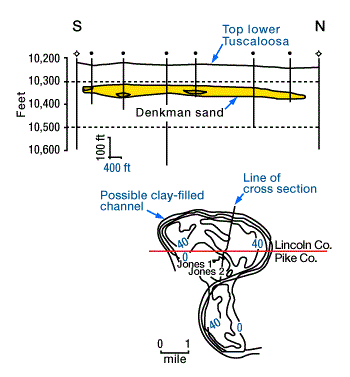Basic Reservoir Characteristics Meandering Channel Alluvial Systems
Because of their high shale content and the often restricted size of individual point-bar deposits, meander channel systems are seldom able to provide laterally extensive reservoirs capable of hosting giant petroleum accumulations. Generally, they support smaller fields, many of which can be found only by serendipity. Most trapping is either stratigraphic or a combination of stratigraphic and structural influences. Lateral fluid flow is limited by:
- surrounding flood-plain shales (extensive)
- abandoned channel clay plugs (local)
Figure 1 (Isopach map and cross section of the Cretaceous Denkman and Little Creek field, Mississippi.

Note the scale of the meander loops and the lenticular nature of the sand body.) shows the lenticular geometry of a typical field in point-bar sands.
A potential drawback that meandering channel complexes share with braided alluvial deposits is that they are often deposited a considerable distance from marine source rocks. However, since many flood plains pass laterally into coastal environments, their channels have sometimes acted as the highest, updip traps for petroleum that has migrated out of marine basin depocenters. In addition, flood plains are sometimes buried beneath transgressive marine sediments, which can serve as both source and seal rock. Alluvial muds are themselves also capable of sourcing a variety of gas-generating kerogen.
 Petro Shine The Place for Oil and Gas Professionals.
Petro Shine The Place for Oil and Gas Professionals.



